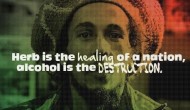A Day in the Eastern Slums of Freetown

From the wharves of Kampala to that of Susan’s Bay, there is an ever growing community, advancing towards the sea; the demographic changes of the last six years has caused the expansion of these once uninhabited areas, which are mostly habited by a youthful population. (Almost 65% of those who live in these areas are youths), ambitious and desperate for a place to live, but at the same time lacking the recourses to afford a more decent housing facility. To get the real side of these communities I endeavor in the direction of lower savage square [Kampala] up to Big wharf for a full day rendezvous of how people cope within these environmentally unfriendly area.
As I venture out early in the morning to spend a day in these wharf communities, I had my first encounter with Lamin Turay, a 29 year old man. Standing on his recently built mud house at the edge of the sea, he moaned that as a boy he never thought of anybody living where he now lives, “it was unthinkable that one would dear live here” the reality now is that the tiny sea front, back of Bishop’s court (Lower Kampala, adjacent to the Queen Elizabeth II quay) is filled to capacity. Lamin like many other youths here are unemployed. Lamin confesses that he was a pirate, but that after seeing the brutal demise of two of his colleagues at sea, he has now decided to drop that career. Ask what he may like to do, he replied, I want to fish, but I don’t have the money to purchase fishing nets. Just a stone throw from Lamin’s mud house there is a much livelier atmosphere as the sounds of reggae music blazed through. Some young men are deeply asleep on the benches while others are chatting with vigor. As huge smoke of marijuana filters through the air some of the young men were bemused by the presence of a stranger, it took me few minutes to assure them that I am not a police or CID officer.
Though the men were in the majority, there were few women around; one of them suggested that I buy them five wraps of marijuana for them to accommodate me.
After doing so they began to talk freely. Isatu, 17, who struggled to talk to me as she puffed marijuana to the air, told me that since 1997 she has not seen any of her relative’s after the war divided them. Asked what she is doing she was quick to reply: ‘me na rarray gyal’ boldly in front of the others, meaning that she is a prostitute “why can’t you go back to your village?” I asked; two things she replied “I don’t know whether my people are still alive and I don’t even have the transport to go back ” Osman a 21 year old man who was awoken by our conversation told me after I asked him why he was sleeping in mid-day, that he has no place to sleep. The owner of the ghetto John said that most of the young men here don’t have somewhere to sleep; you only need to purchase marijuana and have a rest. John a former combatant boasted that he sells the best available marijuana in town.
The sprawling community of lower Kampala has now been merged with that of Moa wharf, which has also witnessed a rapid rise in population over the past six years, a series of settlements recently created now made these communities to look as one. Only, about ten years ago the government had frantically removed the relatively small settlement that of Moa wharf– caterpillars and bulldozers had brushed their way through and destroyed all the shabby settlements. The government forcefully relocated habitants of these areas to the Far East of the city. Citing environmental risks and dangers the government in a bid to salvage a bridge and a drainage leading to the wharf argued that it is unsafe and totally exigent that people be removed from these areas. The aftermath of the war however, which witnessed a breakdown of law and order and the destruction of several houses by the rebels and also the massive movement of refugees and internally displaced people meant that the very limited and underdeveloped housing infrastructure could not cope with the ever growing demands. The result is that most people have resorted to put up in these socially and environmentally dangerous areas like mountain zones and wharves. The dangers and negative features of these communities are not in anyway hidden. They are perceived not only by outsiders but by the inhabitants themselves. Mamadi Kargbo a 33 years old man has been sick for the past nine months; originally, he hails from Makeni where he was a primary school teacher. As a result of a rebel attack in 1998 he was force to flee. Mr. Kargbo has tried to get a job as a primary school teacher, but because he has no formal qualification, his efforts were all futile. Since he fell ill, he has not received any treatment from a medical doctor. Instead he has only been offered traditional herbs and other local remedies. As he strives to show me his picture he took six years ago, one can discern the drop in condition of once a respectful and physique primary school teacher who was lying with bare bones. Just few meters from where he was staying about three other young men were openly easing themselves near the water. One has to be strong to live here, remarked one of the guys, as I cover my nose with handkerchief. The little stretch of soil between the settlements and the sea is strewn and covered with all types of waste, even the sand is hardly visible as torn clothes, tins, waste paper bags, etc are scattered everywhere, there are also dead dogs, cats and mouse all mingling with human feaces. Notwithstanding this odd sight and the offensive smell filtering through the air most of the people in the wharf are simply going about their business, laborers are busy offloading catches of fish from the canoes parked in the wharf. Fish mongers are also serving out their product to be taken to the market for sale. Whilst children are playing hide and seek among the debris of refuse. As I try to leave Moa wharf I met an old man who has stayed in that community for a pretty long time, when I asked him about his point of view of the area he told me that he finds it difficult to live in the area any longer. “If I have another option, I could have moved to another area”. He said to me that most of the young men around here are menace to the society, some of them are pirates, others are pick pocketters and some robbed people at night. Please don’t name me he said. He however, noted that this was not the case before; the war he said has damage our social order. The government must try and do something about these boys if not “we’ve another crisis in the making” he concluded.
If the slums of Moa wharf and Kampala possess a somber scenario, that of Marbella and big wharf are a much bigger and environmentally unfriendly area. Most of the houses in big wharf for instance are build on piles of refuse. The local head of Big wharf, Chief Pa. Alimamy sum up the condition of his area saying that they are suffering; there is no water, no health facility, and no toilet. There is no training facility for the quite a lot of unemployed youths .Another problem he said is that the community is not motorable making it difficult to transport goods and other items. The only job here the chief said is a laborer’s job, most of whom tot wood from canoes to wood shelters. At times I found it difficult to comprehend my position as chief in such a deprived community. We’ve been promised help several times by NGO’s and politicians who sometimes come down here to do surveys. But as you can see there is nothing like development here.
Even the chiefs affected by the social decadence of his community, his house is not much different from the others. Like many other families around here the chief has lost one of his children, infant mortality rate is very high. Dalton M Koroma whose house was burnt by the rebels and who now grinds cassava leaves and groundnut for his survival has lost six out of fourteen children by his two wives, four of them he said died at birth whilst two others died during infancy. There is hardly a family here that has not lost a child. The fact that Sierra Leone has one of the highest infant mortality rate in the world is more evident in this community more than any other. Those who are lucky to survive face a rather tough battle in life. Abdul Mansaray is only 14, but with his mother dead and father paralyzed, he’s out seeking for anything he can tot for the day, he went out of his way to show me bruises and marks he sustained in his rough trade. Only a week ago, he fell over with a pile of wood on his head sustaining a severe injury, all he had was severe beatings and insult of a lazy lizard for falling with the woods.
Amidst the deprivation and poverty in the Big wharf and Marbella community there is also the issue of crime. Sergeant 2446 Alikali Kargbo is the head of the police unit for Marbella and Big wharf, he told me that crimes like common assault, larceny and pick pocketing are on the rise, every day we receive various cases of such crimes, especially during the night hours. But we’re working hard to punish these criminals so as to reduce this trend, he said. Most of the young people here are not doing anything, so the only way some of them feel they can survive is by robbing people. At times we’re overwhelmed as this community is much more bigger. As you can see the place is congested and people are now living at the edge of the sea front. Prostitution is rife also in this community, two prostitute, Tima 14, and Mbalu 15, complained that they are being intimidated by the police to pay what they refer to as their ‘regular dues’ whenever we failed to give them money we’re frightened and sometime arrested until we ‘cooperate’, meaning bribing them before we are allowed to operate freely. When I asked them about the possibility of them contracting hiv/aids, they both wave off their arms saying that aids is a non-existence disease.
If there is any form of entertainment there are only one; the video centre that shows both Nigerian movies and European football that is very popular in the area. Another spot frequented by most of the idle youths is the tiny football field at the edge of Marbella fish harbor that once housed a thriving fishing industry, which served as the source of livelihood for hundreds of youths around the Marbella community. Now that industry is no longer here, its infrastructure lay in ruins. As it has been replaced by small scale fishing. Instead the most visible sight is that of an endless set of footballers and gamblers doing their hobby all day long.












